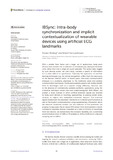Citation link:
http://dx.doi.org/10.25819/ubsi/10186Files in This Item:
| File | Description | Size | Format | |
|---|---|---|---|---|
| IBSync.pdf | 11.52 MB | Adobe PDF |  View/Open |
| Dokument Type: | Article | metadata.dc.title: | IBSync: Intra-body synchronization and implicit contextualization of wearable devices using artificial ECG landmarks | Authors: | Wolling, Florian Van Laerhoven, Kristof |
Institute: | Department Elektrotechnik - Informatik | Free keywords: | Intra-body communication (IBC), Synchronization, Context awareness, Electrocardiography (ECG), Wearable devices | Dewey Decimal Classification: | 004 Informatik | GHBS-Clases: | TWK TZI |
Issue Date: | 2022 | Publish Date: | 2022 | Source: | Frontiers in Computer Science ; 4, 915448. - DOI: https://doi.org/10.3389/fcomp.2022.915448 | Abstract: | With a smaller form factor and a larger set of applications, body-worn devices have evolved into a collection of simultaneously deployed hardware units, rather than into a single all-round wearable. The sensor data, logged by such devices across the user's body, contains a wealth of information but is often difficult to synchronize. Especially the application of machine learning techniques, e.g., for activity recognition, suffers from the inaccuracy of the devices' internal clocks. In recent years, intra-body communication emerged as a promising alternative to the traditional wired and wireless communication techniques. Distributed wearable systems will notably benefit from its advantages, such as a superior energy efficiency. However, due to the absence of commercially available platforms, applications using this innovative technique remain rare and underinvestigated. With IBSync, we present a novel concept in which artificial landmark signals are received by body-worn devices on touching, approaching, or passing certain areas, surfaces, or objects with embedded transmitter beacons. The landmark signals enable both the wearables' intentional or incidental synchronization as well as the implicit contextualization using supplementary information about the beacons' situational context. For the detection of the landmarks, we propose to repurpose the on-board ECG sensor front-end available in recent commercial wearable devices. Evaluated on a total of 215 min of recordings from two devices, we demonstrate the concept's feasibility and a promising synchronization error of 0.80±1.79 samples or 6.25±14.00 ms at a device's sampling rate of 128 Hz. |
Description: | Finanziert aus dem Open-Access-Publikationsfonds der Universität Siegen für Zeitschriftenartikel |
DOI: | http://dx.doi.org/10.25819/ubsi/10186 | URN: | urn:nbn:de:hbz:467-22758 | URI: | https://dspace.ub.uni-siegen.de/handle/ubsi/2275 |
| Appears in Collections: | Geförderte Open-Access-Publikationen |
This item is protected by original copyright |
Page view(s)
282
checked on Nov 24, 2024
Download(s)
79
checked on Nov 24, 2024
Google ScholarTM
Check
Altmetric
Items in DSpace are protected by copyright, with all rights reserved, unless otherwise indicated.

